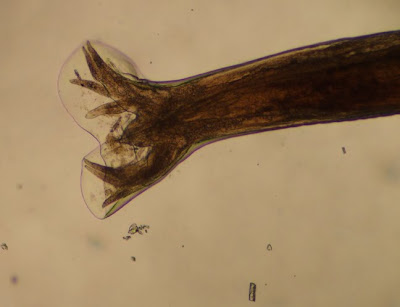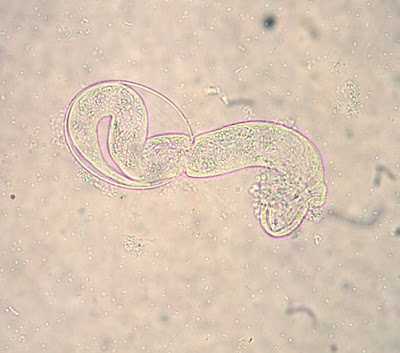Answer: Hookworm; specifically
Necator americanusCmassey said it very well with the following:
"Oh boy! Lots of cool photos! Looks to be Necator americanus with adults in the first photo, eggs and first-stage larva in the second photo, cutting plates in the third photo, bursa of adult male in the fourth photo, followed by eggs and emerging larvae. I feel like this is a trick question but if we plated the aspirate on agar then they should show furrows after some time. Not as well and as deep as Strongyloides but still detectable and more snake-like than whip-like."
Cmassey is correct on all accounts. This is
Necator americanus as evidenced by the cutting plates instead of 'teeth' of
Ancylostoma duodenale. Furthermore, hookworm larvae will indeed create furrows in agar culture, very similar to those created by
Strongyloides stercoralis. If stool is plated directly after being passed, it will take some time for the eggs to mature and hatch the L1 larvae; therefore, it would take a few extra days for the characteristic tracks to be produced in the agar. Remember that hookworm eggs are immature when passed, and take a few days to mature and release larvae. This usually occurs in the soil, but larvae can also be seen in stool when it has been sitting for a few days prior to examination. In this case, the duodenal aspirate was delayed in transit, allowing time for the eggs to mature and hatch.
In regard to the agar culture method, this method was first presented by Tamiki Arakaki in 1988 as a means of increasing the detection of
Strongyloides stercoralis from stool. Since the original description, numerous investigators have shown a significant increase in sensitivity over O&P concentration methods and the Baermann funnel technique. Arakaki also noted that hookworm could be seen by the agar method, but that the furrows were characteristically much thicker than those left by
Strongyloides larvae, and thinner than those left by free-living adults of
S. stercoralis. I'm not sure I would easily be able to tell hookworm from
Strongyloides furrows apart, but we could definitely confirm that the hookworm larvae left macroscopically visible tracks in the agar, by migrating through the agar and dragging bacteria with it.
Here's an image from this case:

Nice tracks!
Finally, Anonymous had a interesting suggestion with "
Ostertagia ostertagi". This is a parasite of cattle, that has rarely been reported from humans - typically in cases where humans and livestock live in close proximity. However, the characteristic morphology of the adults and larvae in this case were consistent with
N. americanus.












